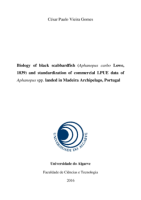Biology and LPUE standardization of Aphanpus spp. commercial data

The black scabbardfish (Aphanopus carbo Lowe, 1839) is a benthopelagic species, member of the Trichiuridae family with great commercial and scientific importance in Madeira Archipelago and in the entire NE Atlantic.
This work, as part of a bicephalous approach, had two main objectives: perform a biological analysis of A. carbo, and to standardize commercial LPUE data of Aphanopus spp. landed in Madeira Archipelago (A. carbo is not separated from the sympatric species A. intermedius for commercial purposes). In terms of A. carbo biology, individuals were collected in Funchal harbour between 2010 and 2015.
In this part of the study, the population structure of A. carbo was analysed through individual length, weight and sex. The reproductive cycle was inferred through the analysis of GSI, HSI and Krel monthly trends. L50s were estimated by fitting maturity ogives and WLRs and LLRs were calculated through regressions. Regarding the LPUE standardization, fishery-dependent data was analysed from 2008 to 2015.
This part focused on fleet characteristics, the performance of landing trends and effort units. Nominal LPUE was standardized through linear model. The factors affecting the variability of LPUE were obtained and analysis of the overall state of the fishery was made. In general, A. carbo females attain the largest length and weight, the overall sex-ratio differed from 1:1 ratio, with females outnumbering males, spawning is performed in the last quarter of the year, L50s were higher in females than in males, and it exhibits isometric growth in terms of WLRs (except for males) and allometric growth in LLRs.
The standardization of commercial LPUE data revealed an hyperstability state in Aphanopus spp. fishery in Madeira EEZ. To compensate lower catches in traditional fishing grounds, fishermen exploit new areas, resulting in stable landing performances. Thus, precautionary management policies are required to sustainably exploit this resource.







